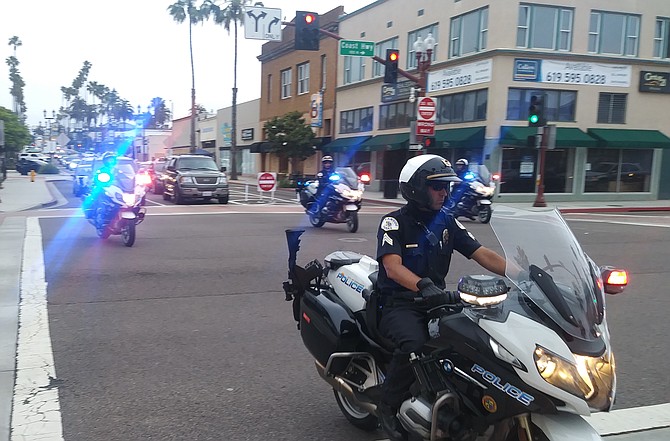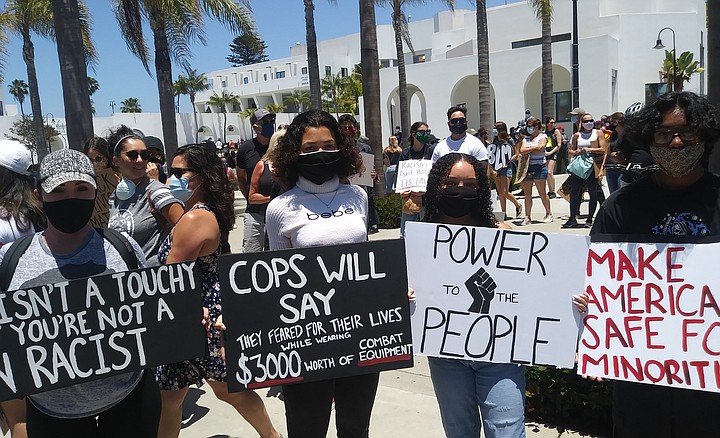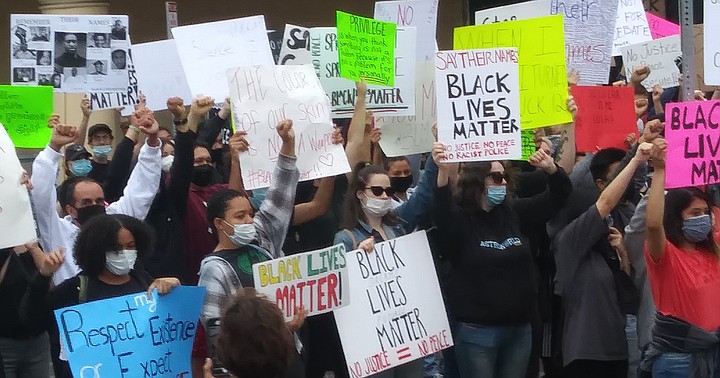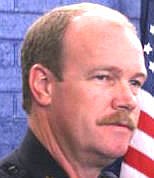 Facebook
Facebook
 X
X
 Instagram
Instagram
 TikTok
TikTok
 Youtube
Youtube

Of the 1,000-plus who attended the Black Lives Matter rally last Sunday afternoon in downtown Oceanside, about a third displayed their emotions on a cardboard sign. Some hoisted self-made posters that referred to bad cop behavior or how we should disband, defund, or decrease the police.
Some of the anti-cop protesters include Aahmya, 16, of Oceanside who says police should not be armed as if they are going off to war and that funds for tasers should be diverted to schools. Sydney, 25, of Oceanside wants money redirected from police budgets to go to the homeless.

An obvious question for them: are you mad about police in general or your local police in particular?
Flor, 17, is an Oceanside local who created a two-color placard that said “Who U gonna call when the murderer wears a badge?.” The word “murderer” was painted in blood red.
She lives in the Posole/Eastside neighborhood. Flor didn’t have any George Floyd-type abuse stories to tell. But she says she is not a fan of Oceanside’s Finest.
“The police are supposed to keep us safe,” explains Flor. “I trust them to protect us. But in my neighborhood, they look the other way. They are always just riding around, looking for somewhere else to be.”

Sunday was the last of five consecutive days of rallies that started at downtown Coast Highway intersections. Rally organizers used bullhorns to implore the mostly young people gathered around to react to injustice, to get out and vote and to not be afraid to fight oppression. At times rally leaders were kneeling on one knee or lying face down on the pavement. While their call-backs were deafening (“No justice, no peace”), there was no violence or looting. After each day’s rally they would then march along the Strand, up Mission Avenue to the WalMart parking lot, or south on Coast Highway to Carlsbad. All the while Oceanside police made sure the marchers were safe and that traffic was diverted.
Police in attendance and rally goers noted how peaceful all five days were. But what of the locals who claimed on signs that the police are “Violently enforcing unjust laws?”
It is unlikely that any of the marchers knew that Oceanside’s chief of police Frank McCoy had just told the city of 175,000 on June 3 that his force will no longer use the choke-hold, and that the George Floyd killing was “alarming and upsetting…it is contrary to any legitimate [police] training.” McCoy says he demands his force intervene if they “witness any unnecessary force being used,” by other officers.

Regarding Flor’s contention that the police ignore her largely Latino Eastside neighborhood, spokesman Tom Bussey responded: “I am sorry she feels that way, but that is totally not true.” He says there are plenty of police officers in unmarked cars in the Neighborhood Enhancement Team who regularly patrol Eastside even though they may be unknown to residents. “Just because she doesn’t notice them doesn’t mean they are not there.”
Unlike Minneapolis, Los Angeles or New York, “No changes to the police budget have been discussed,” says city manager Deanna Lorson. “The city follows all eight of the policies promoted by the Campaign Zero Eight Can’t Wait campaign.”
But last week Lorson referred to a policing problem that impacts most cities: Unlike firefighters, not that many people are clamoring to be cops. “We know [the Oceanside police] has faced hiring challenges in finding highly qualified police officers,” says Lorson.
“That’s nothing new,” says spokesman Bussey. “This is not a problem unique to George Floyd. Every department in the county has had issues with that. It’s been going on for years. It’s not just our department, it’s all over. Look at San Diego. They are really down a lot [in police recruitment].”
Bussey says when he was brought on to the force in the 70s he was selected from a group of over 300. “It’s tough to get people now. I guess people would rather do something else.”
But the testing for new police recruits remains tough says Bussey. “There are pretty rigorous tests to join a police department. There is a physical agility test, written tests, psychiatric evaluation, a polygraph…there are a number of things you still have to go through.”
In Oceanside, when candidates are hired, they then go through a 26-week academy and then partner up for on-the-job field training for another 24 weeks.
The Oceanside police department has 184 budgeted positions. There are 17 vacancies. City manager Lorson says there are 10 new hires starting the academy this month. “This number is constantly in flux as officers decide to retire and not all new hires successfully complete the academy.”
But police pay does not seem to be an issue in Oceanside. According to Transparent California, five of the top ten salaries paid by Oceanside last year were earned by a member of the police. Last year Chief McCoy was the highest paid city employee; he got $400,984 in total pay and benefits. Second highest was officer Gary Alexis who made $384,601 in 2019. Oceanside’s top 10 earners for 2019 also included police Captains Manuel Armijo ($309,912) and Sean Marchand ($300,565) and Sergeant Jack Reed ($294,322).
The lack of a full staff may be working in favor of Oceanside’s rank and file. Last July NBC-7’s Alex Presha reported that Oceanside paid out over $3.86 million in police overtime, with some officers making more in overtime than they do in regular pay. At the time Lorson said that overtime is not such a bad thing: “It is generally more cost effective than to hire additional staff due to the cost of benefits, primarily retirement.”
A request to get a comment on police overtime from Oceanside Police Officers Association Jim Ridenour was not returned.
Longtime Oceanside locals know that the Oceanside police department owns a tank-like military assault vehicle that could be used in SWAT or hostage operations. Police spokesman Bussey says he does not remember the last time it was put to use.


Of the 1,000-plus who attended the Black Lives Matter rally last Sunday afternoon in downtown Oceanside, about a third displayed their emotions on a cardboard sign. Some hoisted self-made posters that referred to bad cop behavior or how we should disband, defund, or decrease the police.
Some of the anti-cop protesters include Aahmya, 16, of Oceanside who says police should not be armed as if they are going off to war and that funds for tasers should be diverted to schools. Sydney, 25, of Oceanside wants money redirected from police budgets to go to the homeless.

An obvious question for them: are you mad about police in general or your local police in particular?
Flor, 17, is an Oceanside local who created a two-color placard that said “Who U gonna call when the murderer wears a badge?.” The word “murderer” was painted in blood red.
She lives in the Posole/Eastside neighborhood. Flor didn’t have any George Floyd-type abuse stories to tell. But she says she is not a fan of Oceanside’s Finest.
“The police are supposed to keep us safe,” explains Flor. “I trust them to protect us. But in my neighborhood, they look the other way. They are always just riding around, looking for somewhere else to be.”

Sunday was the last of five consecutive days of rallies that started at downtown Coast Highway intersections. Rally organizers used bullhorns to implore the mostly young people gathered around to react to injustice, to get out and vote and to not be afraid to fight oppression. At times rally leaders were kneeling on one knee or lying face down on the pavement. While their call-backs were deafening (“No justice, no peace”), there was no violence or looting. After each day’s rally they would then march along the Strand, up Mission Avenue to the WalMart parking lot, or south on Coast Highway to Carlsbad. All the while Oceanside police made sure the marchers were safe and that traffic was diverted.
Police in attendance and rally goers noted how peaceful all five days were. But what of the locals who claimed on signs that the police are “Violently enforcing unjust laws?”
It is unlikely that any of the marchers knew that Oceanside’s chief of police Frank McCoy had just told the city of 175,000 on June 3 that his force will no longer use the choke-hold, and that the George Floyd killing was “alarming and upsetting…it is contrary to any legitimate [police] training.” McCoy says he demands his force intervene if they “witness any unnecessary force being used,” by other officers.

Regarding Flor’s contention that the police ignore her largely Latino Eastside neighborhood, spokesman Tom Bussey responded: “I am sorry she feels that way, but that is totally not true.” He says there are plenty of police officers in unmarked cars in the Neighborhood Enhancement Team who regularly patrol Eastside even though they may be unknown to residents. “Just because she doesn’t notice them doesn’t mean they are not there.”
Unlike Minneapolis, Los Angeles or New York, “No changes to the police budget have been discussed,” says city manager Deanna Lorson. “The city follows all eight of the policies promoted by the Campaign Zero Eight Can’t Wait campaign.”
But last week Lorson referred to a policing problem that impacts most cities: Unlike firefighters, not that many people are clamoring to be cops. “We know [the Oceanside police] has faced hiring challenges in finding highly qualified police officers,” says Lorson.
“That’s nothing new,” says spokesman Bussey. “This is not a problem unique to George Floyd. Every department in the county has had issues with that. It’s been going on for years. It’s not just our department, it’s all over. Look at San Diego. They are really down a lot [in police recruitment].”
Bussey says when he was brought on to the force in the 70s he was selected from a group of over 300. “It’s tough to get people now. I guess people would rather do something else.”
But the testing for new police recruits remains tough says Bussey. “There are pretty rigorous tests to join a police department. There is a physical agility test, written tests, psychiatric evaluation, a polygraph…there are a number of things you still have to go through.”
In Oceanside, when candidates are hired, they then go through a 26-week academy and then partner up for on-the-job field training for another 24 weeks.
The Oceanside police department has 184 budgeted positions. There are 17 vacancies. City manager Lorson says there are 10 new hires starting the academy this month. “This number is constantly in flux as officers decide to retire and not all new hires successfully complete the academy.”
But police pay does not seem to be an issue in Oceanside. According to Transparent California, five of the top ten salaries paid by Oceanside last year were earned by a member of the police. Last year Chief McCoy was the highest paid city employee; he got $400,984 in total pay and benefits. Second highest was officer Gary Alexis who made $384,601 in 2019. Oceanside’s top 10 earners for 2019 also included police Captains Manuel Armijo ($309,912) and Sean Marchand ($300,565) and Sergeant Jack Reed ($294,322).
The lack of a full staff may be working in favor of Oceanside’s rank and file. Last July NBC-7’s Alex Presha reported that Oceanside paid out over $3.86 million in police overtime, with some officers making more in overtime than they do in regular pay. At the time Lorson said that overtime is not such a bad thing: “It is generally more cost effective than to hire additional staff due to the cost of benefits, primarily retirement.”
A request to get a comment on police overtime from Oceanside Police Officers Association Jim Ridenour was not returned.
Longtime Oceanside locals know that the Oceanside police department owns a tank-like military assault vehicle that could be used in SWAT or hostage operations. Police spokesman Bussey says he does not remember the last time it was put to use.
Comments